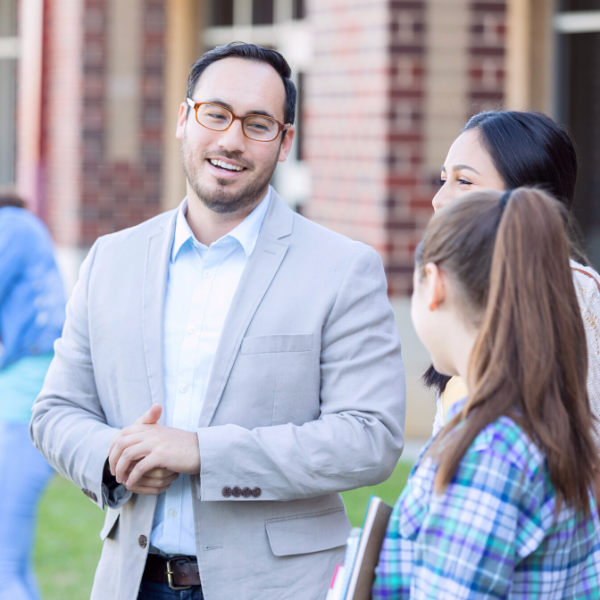
Karla Phillips-Krivickas is the senior policy director for KnowledgeWorks and founder of Inclusive Strategies. A long-time advocate for innovation and personalization, especially on behalf of students with disabilities, Karla works with federal, state, and local leaders to build and adopt policies and practices that advance academic achievement for all students.
As part of our Hop, Skip, Leapfrog interviews with subject-matter experts across the K-12 field, we asked her to weigh in on education policy opportunities in a post-pandemic world. Read on for three big ideas from our conversation, in Karla’s words.
Takeaway #1: COVID-19 Shifted Policy Overnight, But We’ll Need To Keep Working To Get The Right Long-Term Solutions in Place
For years, I’ve been talking to states and presenting at conferences saying, “We need to do things differently.” And, for the most part, it’s fallen on deaf ears. In the thinking of “hop, skip and leapfrog,” most people wanted to start, maybe, “skipping.’”We started seeing pilot programs, innovation zones, but for the most part, it wasn’t a substantial change.
But overnight, the world changed. Just about everybody now recognizes that the traditional one-size-fits all is not working for kids and probably never really was. And so all of the things that we had been identifying as policy obstacles over the years were dealt with in a snap of a finger. You see them in the executive orders, emergency directives and waiver applications. Those were the things that were preventing schools from being able to shift quickly and be nimble to serve the needs of kids, but coincidentally, they are also the same things that were really hampering schools’ abilities to transition to more personalized, competency-based policies.
The things that we used to call ‘nontraditional’ programs and calendars, have quickly become the norm and they’re not going away. And we need to give policy makers and district leaders those talking points — that the things that we used to consider nontraditional are now permanently part of our ecosystem. But, a lot of the infrastructure and policy we’ve been building upon was created for [what was once] outside the norm, the small, tiny fraction of schools. This could be truly the “disruptive innovation” moment, right? With the exception that we have highly regulated that early disruptive stuff. But now that we had to expand [those regulations] really quickly, we’re dealing with a set of rules that makes zero sense when applied to the entire system. This is particularly true for online learning policies and programs.
We’ve got some states that were making “hops” through the crisis, such as through emergency waivers. And now there’s some that are wanting to “skip,” and a couple that are “leapfrogging. “ The “leapfrog” states are also the ones who were creating the most momentum long before the pandemic.
Takeaway #2: Tackling “Seat Time” and Moving Towards Mastery-Based Models Will Mean Painting A Vision of What We Want, Not What We Don’t
I think that around policy shifts, we see so many constraints around ourselves that they keep us from doing “the thing.” How do we, rather than focusing on the barriers, position the opportunity in conversations in a way that is grounded in what we know is good learning and teaching, make that case, and then point to the thing that’s in our way of doing it?
For example, I don’t like the phrase “getting rid of seat time” because some people will interpret that as we want students to get less time and go through school faster. Our never ending struggle with competency-based learning is that some interpret the goal as having students accelerate [often by themselves] through some online stuff and in the end the state will save money. But that’s not the goal.
What educators do need is flexibility on how that time looks, how it can be measured and reported, where it can happen and how it can happen. So when you get to the crux of that, often in states, it’s the definition of instruction that needs to change. In some states that’s in legislative statute, some in a state board rule, and in some it’s found in reporting or auditing guidelines that determine what instruction needs to look like.
It’s difficult to both identify a policy barrier and get agreement on a fix. However, it’s more helpful to discuss your vision for learning and how a policy is hindering your implementation. It’s much more productive to garner support for a new idea than it is to advocate simply eliminating policies that may have, historically, been viewed as holding the system accountable.
That’s why I’ve begun to talk more about changing the evidence of learning and evidence for funding rather than getting rid of seat time. Because nobody will argue that seat time was ever a really good proxy for either.
Takeaway #3: Helping States Create Flexibility That Is Focused on Outcomes and On Learning Rather Than Instruction — Policymakers Need the Vision
Time-based policies are different in every state. The tentacles go deep in policy down to auditing and reporting requirements, so it’s very hard to disentangle it. I think the hyper constrictive policy reactions we saw last year [such as requiring set minutes of synchronous screen time] were knee-jerk reactions to the extreme stories we were all hearing. So you really can’t blame policymakers for the responses when we weren’t providing them with alternatives.
I think the best thing we can do for states is to develop and share innovative policy solutions to complement the innovative learning strategies that schools are quickly pivoting to. We need to help educators communicate their experiences and how policies may have hindered their ability to pivot quickly. I think just about everyone saw the education system through a different lens — literally. And certainly there were glimmers, but policymakers need to hear them and how the flexibility and support that was provided empowered their success.
I always come back to communication. As more states demonstrate and give examples to other states, I think we’ll see movement. Fast.
This blog is one in a series describing interviews from TLA’s Hop, Skip, Leapfrog project. Explore more resources here.

